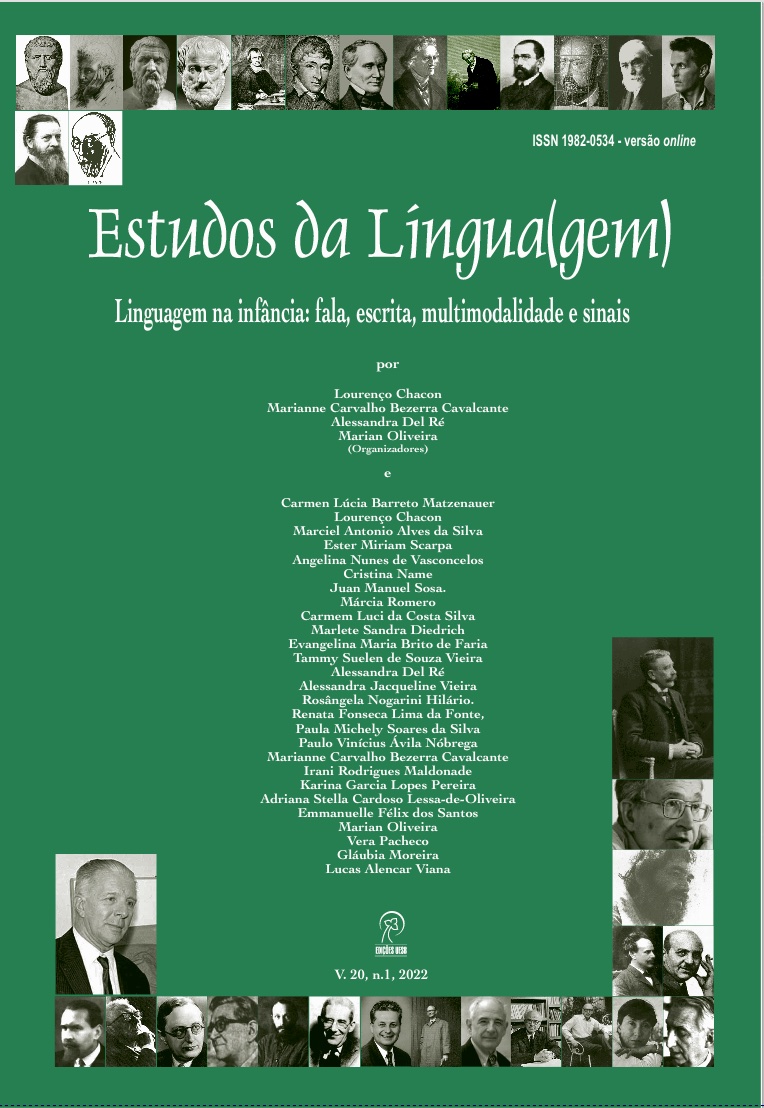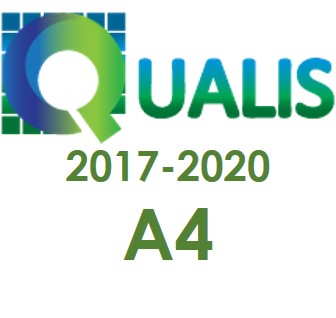Studies in Language Acquisition and Multimodality in Northeast Brazil
DOI:
https://doi.org/10.22481/el.v20i1.12076Keywords:
Aquisição da Linguagem no Nordeste; Multimodalidade; Crianças Típicas e Atípicas.Abstract
Language studies in the early processes of typical and atypical children have been occurring in a very productive growth in recent years. Our objective is to present research discussions in Language Acquisition developed in the Northeast of Brazil, specifically in the States of Paraíba and Pernambuco, from the point of view of multimodality. For this, from the database of study laboratories of these northeastern states, we will discuss some qualitative and longitudinal investigations that contemplate different contexts: initiatives for interaction of atypical children, considering the specificity of Down Syndrome and Spectrum Disorder Autistic, and reporting of the genre recipe by children of different nationalities. The research data collection took place in different loci, including clinic, coexistence group and home environment. The results show how fruitful the development of the Language Acquisition field has been with different corpora analyzed from a multimodal linguistic perspective.
Downloads
References
ÁVILA-NÓBREGA, P. V. Dialogia mãe-bebê: a emergência do envelope multimodal em contextos de atenção conjunta. 2010. 165 f. Dissertação (Mestrado). UFPB: João Pessoa, 2010.
_____. O Sistema de Referenciação Multimodal de Crianças com Síndrome de Down em Engajamento Conjunto. 206 f. Doutorado (Tese em Linguística) Universidade Federal da Paraíba, João Pessoa, 2017.
_____. O Estudo do envelope multimodal como uma contribuição para a aquisição da linguagem. Curitiba, Editora Appris, 2018.
BAITELLO JÚNIOR, N. Comunicação, mídia e cultura. São Paulo em Perspectiva, São Paulo, v. 12, n. 4, 1998.
BUTCHER, C; GOLDIN-MEADOW, S. Gesture and the transition from one-to two-word speech: when hand and mouth come together. In: MCNEILL, David. (ed.). Language and Gesture. Cambridge: Cambridge University Press, 2000, p. 235-257.
CARDOSO, C. O corpo presente. In: RUBIM, A. A. C; BENTES, I. M. G.; PINTO, M. J. (Org.). Comunicação e sociabilidade nas culturas urbanas contemporâneas. Petrópolis: Vozes, 1999. p. 41-53.
CAVALCANTE, M; et al. Sincronia gesto-fala na emergência da fluência infantil. Estudos Linguísticos. São Paulo, v. 45, p. 411-426, 2016.
_____; FONTE, R. Panorama das pesquisas em aquisição da linguagem no Nordeste brasileiro. In: Cleber Ataíde et al. (Org.). Cartografia Gelne: 20 anos de pesquisas em Linguística e Literatura. 1ed.Campinas: Pontes Editores, 2019, v. 1, p. 287-322.
CAVALCANTE, M. C. B. Gestos: da marginalidade à proeminência na aquisição da linguagem. Mesa-Redonda: Multimodalidade nos estudos sobre a linguagem da criança do GT de Estudos em Aquisição da Linguagem Oral e Escrita. XXXV ENANPOLL, Londrina, 09 a 12 de dezembro de 2020.
CHACON, L; VILLEGA, C. C. S. Hesitações na fala infantil: indícios da complexidade da língua. Cadernos de Estudos Linguísticos, São Paulo, v.54, p.81 - 95, 2012.
CRUZ, F.. Documentação multimodal de interações com crianças com Transtorno do Espectro do Autismo: corpo, língua e mundo material. Calidoscópio, v. 16, p. 179-193, 2018.
_____. Elementos para uma análise multimodal da interação: um exemplo de correlação linguístico-gestual no autismo. In: GONÇALVES-SEGUNDO, P. R.; MODOLO, A. D. R.; SOUSA, D. R. de; FERREIRA, F. M.; COAN, G. I.; BRITTO-COSTA, L. F. (Org.). Texto, discurso e multimodalidade: perspectivas atuais. 1ed.São Paulo: Editora Paulistana, 2017, v. 1, p. 158-179.
_____; ANDREATTO, N. Um estudo exploratório da notação de gestos em interações com crianças autistas. REVISTA PAPEIS, v. 24, p. 81-102-102, 2020.
_____; COTS, C. Práticas corporificadas de construção da atenção conjunta em interações de uma criança diagnosticada com transtorno do espectro do autismo. Revista intercâmbio, v. XLVII, p. 112-136, 2021.
FONTE, R. F. L. da. O funcionamento da atenção conjunta na interação mãe-criança cega. 315f. Tese (Doutorado em Linguística) – Programa de Pós-Graduação em Linguística, Universidade Federal da Paraíba, 2011.
_____. Compreendendo a atenção conjunta e aquisição de linguagem nas especificidades da cegueira. DLCV – Língua, Linguística & Literatura, v. 10, n. 1 e 2, p. 33-46, 2013.
_____. Cenas de atenção conjunta na interação mãe-criança cega: contribuições à aquisição da linguagem. Signótica, v. 25, n. 2, p. 393-412, 2014.
_____; CAVALCANTE, M. C. B. Abordagem multimodal da linguagem: contribuições à clínica fonoaudiológica. In: MONTENEGRO, A. C. A. de; RÊGO BARROS, I; AZEVEDO, N. P. S. G. de. (org.). Fonoaudiologia e Linguística: teoria e prática. Curitiba: Appris, 2016, v. 1, p. 205-225.
_____; COSTA, N. Q. da. Fluência/disfluência na gesticulação e na fala de sujeitos com gagueira. Prolíngua, 12 (1), 2017, p. 17-26.
_____; CAVALCANTE, M. C. B. Gestos dêiticos e atenção conjunta nas especificidades do autismo: uma abordagem multimodal. In: ÁVILA NÓBREGA, P. V. (org.). Nuances da Linguagem em Uso. Campina Grande: EDUEPB, 2018, p. 159-299.
_____; BARROS, I. Estereotipias motoras no funcionamento multimodal da linguagem: discussões no campo do autismo. Estudos da Língua(gem), v. 17, n. 1, p. 127-140, 2019.
_____; SILVA, K. V. N. Multimodalidade na linguagem de crianças autistas: o 'não' em suas diversas manifestações. Prolíngua (João Pessoa), v. 14, p. 250-262, 2019.
FONSECA, V. Desenvolvimento Psicomotor e Aprendizagem. Porto Alegre: Artmed, 2008.
GALARD, J. A Beleza dos Gestos: uma estética das condutas. Tradução de Mary Amazonas Leite de Barros. São Paulo: Edusp, 1997.
GOLDIN-MEADOW, S. From gesture to word. In: BAVIN, E. L. (ed.). The Cambridge handbook of child language. University of Cambridge Press, 2009, p. 145-160.
_____. Homesigns: When gesture is called upon to be language. In: MÜLLER, C.; et al (eds.) Body-Language-Communication: An international handbook on multimodality in human interaction. Berlin: Mouton de Gruyter, 2013, p.113-125.
KENDON, A. The study of gesture: some remarks on its history. Recherches sémiotiques/semiotic inquiry, 2, 1982, p. 45-62.
_____. Language and gesture: unity or duality? In: MCNEILL, D. (ed.). Language and gesture. Cambridge: Cambridge University Press, 2000, p. 47-63.
_____. Language matrix. Gesture, 2009, 9 (3), p. 352-372.
_____. Reflections on the “gesture-first” hypothesis of language origins. Psychonomic Bulletin & Review, v. 24, n. 1, p. 163-170, 2016.
LOPES, J. C. M. Dinâmicas dialógicas singulares: a multimodalidade na criança com autismo. 156f. Tese (Doutorado em Linguística) – Programa de Pós-Graduação em Linguística, Universidade Federal da Paraíba, 2011.
MCNEILL, D. So you think gestures are nonverbal? Psychological Review, v. 92, n. 3, p. 350-371, 1985.
_____. Hand and mind: What gestures reveal about thought. Chicago: University of Chicago Press, 1992.
_____. Introduction. In: MCNEILL, D. (ed.). Language and Gesture. Cambridge: Cambridge University Press, 2000.
POLIA, A. A. Aquisição de linguagem nas especificidades da encefalopatia crônica não progressiva: uma abordagem multimodal. 312f. Tese (Doutorado em Linguística) – Universidade Federal da Paraíba, João Pessoa, 2019.
PROSS, H. Medienforschung. Film, funk, presse, fernsehen. Darmstadt, Carl Habel, 1972.
ROWE, M; GOLDIN-MEADOW, S. Early gesture selectively predicts later language learning. Developmental Science, v. 12, n. 1, p. 182-187, 2009.
SOARES da S, P. M. Multimodalidade em cenas de atenção conjunta: contribuições para o processo de aquisição da linguagem de uma criança surda. 2018. 188f. Tese (Doutorado em Linguística) - Universidade Federal da Paraíba, João Pessoa, 2018.
TOMASELLO, M. (2003). Origens Culturais da Aquisição do Conhecimento Humano. Tradução de Cláudia Berliner. Martins Fontes: São Paulo.
Downloads
Published
How to Cite
Issue
Section
License

This work is licensed under a Creative Commons Attribution 4.0 International License.

Estudos da Língua(gem) is licensed under a Creative Commons Attribution 4.0 International License.
Authors who publish in the journal Estudos da Língua (gem) agree with the following terms:
The journal Estudos de Língua(gem) maintains the copyrights of the contributions published. These rights include the publication of the contribution and make its content available for free through the portal.







